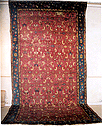| |
CARPET
FROM SHUSHA CITY
January 2003
Carpet weaving
was an established practice of Shusha City. Indeed, at the turn
of the 20th century, it was the stylistic leader of Caucasia. (1)
Shusha came into being as a result of a citadel built on a remote
mountain by a khan of Karabagh, who had a habit of creating such
fortified places, (2) common practice for local rulers on the fringe
of empire, especially that of Nadir Shah and unsurprising for a
local khan who previously had been expelled by Nadir Shah from a
neighboring district. Shusha became a place on the map in 1752 with
the completion of its wall. (3) Europeans visiting the area in the
1820's and '30's knew the city's history, described it, and noted
its size, 2000 houses circa 1830, and population, predominantly
Azeri. (4)
There is a
spurious attribution of a class of late17th and early 18th century
rugs, the so-called dragon carpets, to Shusha, made a long time
ago by Charlie Ellis, in all innocence. Which is the problem; he
didn't know the place did not exist at the purported time of manufacture
of the rugs. Yet there are real Shusha City rugs; some are extant,
somewhat surprisingly, a number at the Glencairn Museum, Bayn Athyn,
Pa.. These have been described; dated examples are from the mid-19th
century, and one is earlier, 1809. (5) Yet another Shusha City rug
showed up recently, at the International Art and Antiques Fair in
New York, fall of 2002, in the Galerie Chevalier (Paris) booth.
 Illustrations
of this rug, which is large, appear hear courtesy of Dominique Chevalier.
The standard Herati pattern and accompanying borders bear a clear
resemblance to a similar Shusha rug photographed circa 1910, see
detail. (6) A pleasure to see this variety of large handsome carpet
in good condition. Its identification occurred during the show's
vetting process, and it was Posy Benedict who first tumbled as to
the type. Illustrations
of this rug, which is large, appear hear courtesy of Dominique Chevalier.
The standard Herati pattern and accompanying borders bear a clear
resemblance to a similar Shusha rug photographed circa 1910, see
detail. (6) A pleasure to see this variety of large handsome carpet
in good condition. Its identification occurred during the show's
vetting process, and it was Posy Benedict who first tumbled as to
the type.
|
|
|
|
Click
on images to enlarge.
|
The dated inscription,
see detail, however, is cause for some head scratching, because
something is wrong. All is clearly woven, including requisite soft
signs, a bit illegible at the end of the cramped word for year,
but there. "Navruz" is a transliteration distortion of
the Azeri word, novruz, the term for the beginning of the new year
at the vernal equinox (nov + ruz = new + day). An old celebration,
dating perhaps from Zoroastrian times, widely observed in western
Asia and referred to in words with slightly different vowels both
in Persian and in Turkish. (7)
The problem
is the incompatibility of the clearly rendered date, 1811, combined
with a Russian inscription. There were no Russians in Shusha at
this time, and would not be for a good while after the ceding of
the area to Russia a decade later; Russians, moreover, would not
be celebrating events of another culture and calendar. If, however,
the date is read either as 1877, or 1871, (but not 1817) everything
falls into place -- the rug was intended for an Azeri purchaser
in a Russian-speaking milieu. Indeed, the rug looks like a 3rd quarter
19th century product.
The unraveling
of the contradiction seemingly must be that either the person who
wrote the cartoon to be followed, or the weavers, couldn't differentiate
"7" 's from "1" 's. But there is a difficulty
with this speculation, for a Russian "7", has a little
cross piece on its shaft distinguishing it from a "1".
So, either the cartoon was defective, or the weavers (who may or
may not have known Arabic numerals where a "7" is quite
different -- no corrective there) were careless. Not likely, given
their care in rendering the letters.
A nice little
mystery. The more likely explanation seems to be that the date was
wrongly rendered, probably by the cartoonist, and that the rug was
woven in the 1870's.
Notes
- Prakov,
A. V. et al, Russkoe narodnoe isskustvo na vtoroi vserossiiskoi
vystavke, Petrograd, 1914, p. 8.
- Bournoutian,
George A., Tarikh-e Quarabagh, annotated translation, Costa
Mesa, 1994, passim, esp. pp. 71/72.
- Wertime,
John T., and Wright, Richard E., "The Tabriz Hypothesis",
Asian Art I, p. 36, note 22.
- Keppel,
George, Travels, Vol. II, London, 1827, p. 184; Smith, Eli,
Researches of the Rev. E. Smith and the Rev. H. G. O. Dwight
in Armenia, Vol. I, pp. 279-281.
- O'Bannon,
George, "A Group of Rugs Attributed to Shusha",
Oriental Rug Review, Apl/May 1990, Vol. 10, No. 4, p. 12.
- Piralov,
A.S., Kratkii ocherk kustarnyk promyslov vystavke, Petrograd,
1914, p. 60.
- Information
courtesy of Ayten Kazimova, of Baku and Istanbul, who knows
these things.
|
|
